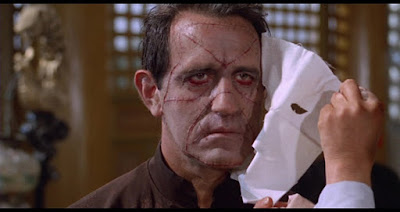 |
| Christopher Lee, actually playing Sax Rohmer's Emperor of Crime in Hong Kong. |
 |
| Douglas Wilmer, Howard Marion-Crawford. |
 |
| Maria Rohm, Horst Frank. |
 |
| Peter Carsten, Tony Ferrer. |
 |
| Douglas Wilmer. |
 |
| Ditto. |
 |
| Maria Rohm. |
 |
| Christopher Lee. |
 |
| Noel Trevarthan, Tony Ferrer and "motley crew" under cover. |
 |
| Horst Frank and torture chamber props going to waste. |
Once again, I have reviewed the film working from the imported Momentum DVD release of THE FU MANCHU TRILOGY of 2001, which includes a trailer. The image grabs used here are from that Kinowelt/Studio Canal-sourced release. The film has since been released domestically as a DVD-R from the Warner Archive Collection. I have not seen that version and cannot verify whether or not the American cut differs from this one in any way.
(c) 2018 by Tim Lucas. All rights reserved.